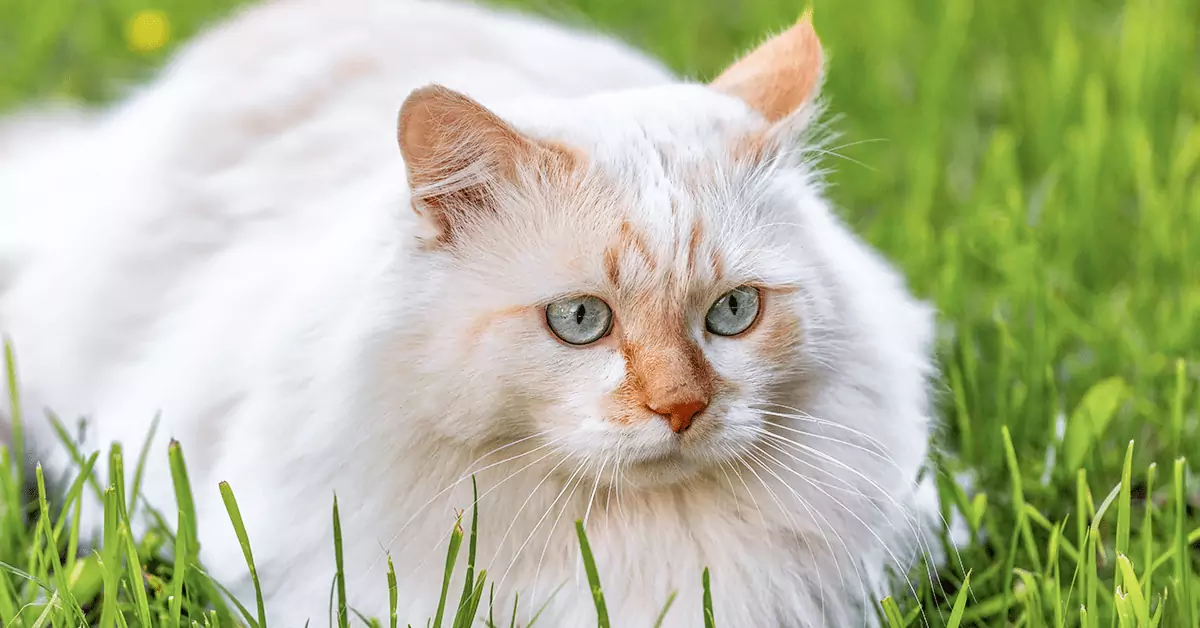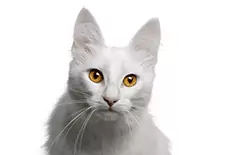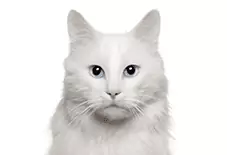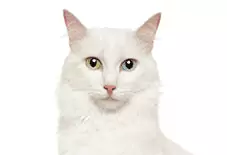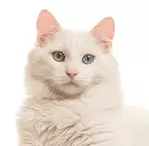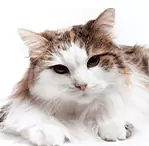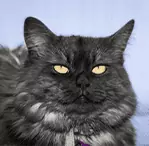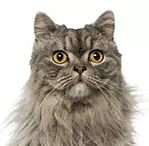
Best Fur Friend

High Kitty I.Q.

Social Butterfly
Want a graceful beauty with a big personality and a bigger heart? Then I’m the breed for you! We Turkish Angoras are known for our elegance, which is why the
humans call us the ballerinas of the cat world! I’m very loving – if a bit clingy – so I do best in a home where I’m not left alone for too long. I can get along with kids and cat-friendly
pets, but I’ve got an alpha personality, so I’ll let them know who’s boss! I’m an outgoing and social cat who needs all eyes on me, and I’ll use my smarts and mischievous nature to make sure they are. Don’t be surprised to find me opening cabinets or knocking stuff over to get your attention! But It doesn’t take as much work as you’d think to keep me looking furbulous – twice-weekly brushing is enough. I’m also pretty athletic and need daily exercise to work my energy out, so stock up on interactive toys and make time to play with me! Even though I can be a bit of a handful sometimes, the humans can’t get enough of my stunning looks and charming personality.
关于我
Personality
Affectionate
Outgoing
Smart
Coat Details
Type
Longhair
Texture
Soft and Silky
Colors
White, Black, Blue, Cream, Red, Silver, Brown
Pattern
Tabby, Tortoiseshell, Calico, Smoke, Shaded, Bicolor

My Many Looks

My Breed Characteristics

Furbulous Fact
Some Turkish Angoras have a genetic condition called heterochromia, which is linked to white fur. The humans call this look “odd eyes,” and white Turkish Angoras with these genes will have one blue eye and one green, green-gold, or amber eye. This rare look is prized by Turkish Angora lovers, but (as in other breeds) white fur and blue eyes can be linked to deafness. Not all odd-eyed Turks are deaf, but deaf kitties need love, too!

As I Grow Up
As you can see, we Turkish Angoras age pretty gracefully. Here are a few key milestones in my growth & development to be aware of as I grow up from a kitten to an adult and senior!

History of My Breed
We Turkish Angoras are a very old breed. My earliest ancestors evolved naturally from the African wildcat – they lived in the Ankara region of Turkey (then called Angora). The humans think our long fur first evolved to protect us from the cold in the Turkish mountains. My ancestors came to Europe in the 16th century, and our grace and beauty made us popular among royalty in Great Britain and France. Queen of France Marie Antoinette famously loved our breed, and some humans believe that, when she was attempting to flee France during the French Revolution, she put her six Turks on a ship to America, where they bred with domestic cats to create the Maine Coon! In late-19th- and early-20th-century Europe, Turkish Angoras were featured prominently in cat shows, but the growing popularity of the Persian breed almost wiped us out. The humans saw how gorgeous our coats were, and they started breeding us with Persians to make their coats as nice as ours, but we almost went extinct as a separate breed in the process. Luckily, humans at the Ankara Zoo in our ancestral home of Turkey considered us a national treasure, and they started a strict breeding program to bring us back. The Ankara Zoo program focused on white Turkish Angoras with blue, gold, or odd eyes, and the striking looks of these traditional Turks caught the eyes of American servicemen who were stationed in Turkey. In 1962, the breeders at the zoo allowed Colonel Walter Grant to take two Turks back to America, where he started a breeding program. In 1973, the Cat Fanciers’ Association recognized us, but only white Turkish Angoras were allowed. The CFA didn’t recognize colored Turkish Angoras until 1978. While some humans still think my white brothers and sisters are the most beautiful, today all of our colors and patterns are celebrated by Turkish Angora lovers around the world.

Care Tips
from Dr. Jessica Greenberg, Associate Veterinarian
1
Brush your Turkish Angora often to avoid hairballs.
Turkish Angora cats have medium-long fur coats, which require brushing once to twice a week with a fine toothed comb. This will help reduce excess hair, prevent matted fur, and reduce the possibility of hairballs. Anti-hairball oral supplements, such as Cat Lax paste, can be offered to help break these down.
2
Keep an eye on your Turkish Angora’s eyes.
Their long fur can also predispose Turkish Angoras to irritation around their eyes. To avoid discharge accumulation, clean around their eyes with a damp cloth to remove debris. This will reduce risk of bacterial conjunctivitis. Long hair at the corner of the eye can cause direct irritation on the surface of the eye itself, which can cause corneal ulcers, so make sure this area of fur is trimmed.
3
Keep your white Turkish Angora indoors.
Due to lack of skin pigmentation, white Turkish Angoras are more at risk for sunburn. For this reason, they are more suited to indoor living. White Turkish Angoras with blue or odd eyes are more prone to being deaf. If this is the case they may appear louder when vocalizing. Although cats adapt well to being deaf, it is better to keep them indoors to avoid the risks of being outside (i.e. not hearing for dangers like cars or other animals).

Training Tips
from Dr. Jessica Greenberg, Associate Veterinarian
